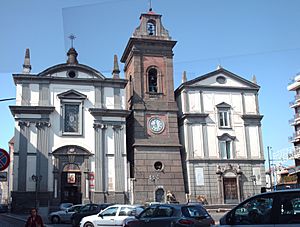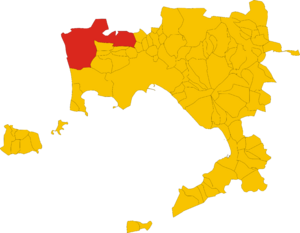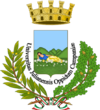Giugliano in Campania facts for kids
Quick facts for kids
Giugliano in Campania
|
||
|---|---|---|
| Comune di Giugliano in Campania | ||

Church of the Annunziata
|
||
|
||
 |
||
| Country | Italy | |
| Region | Campania | |
| Frazioni | Lago Patria, Varcaturo, Licola | |
| Area | ||
| • Total | 94.62 km2 (36.53 sq mi) | |
| Population
(31 August 2017)
|
||
| • Total | 124,139 | |
| • Density | 1,311.97/km2 (3,398.00/sq mi) | |
| Demonym(s) | Giuglianesi | |
| Time zone | UTC+1 (CET) | |
| • Summer (DST) | UTC+2 (CEST) | |
| Postal code |
80014
|
|
| Dialing code | 081 | |
| Patron saint | St. Iulianus | |
| Saint day | January 27 | |
Giugliano in Campania is a city in Italy, located in the Metropolitan City of Naples in the Campania region. It is often simply called Giugliano. This city is a suburb of Naples. In 2017, about 124,000 people lived there. This makes it the most populated Italian city that is not a capital of a province.
Contents
History of Giugliano
Ancient Times
Around 500-400 BCE, the area of Giugliano was home to the Osci people. They built many cities, including Atella and Liternum. These cities became very successful when Rome took over. This area was known as Terra di Lavoro, which means "Land of Work". It was the most fertile part of the Campania region.
Near a place called "Lake Patria", there was an old city named Liternum. In 194 BCE, it became a Roman colony. A famous Roman general, Scipio Africanus, lived and died there. His tomb and home were described by the writer Seneca the Younger. In 455 CE, the city was attacked and destroyed by Genseric and his Vandals. The people who survived moved to where Giugliano's historic center is today.
Middle Ages and Later
Giugliano stayed a small town until 1207. That year, the city of Cuma was destroyed by people from Naples. Some citizens from Cuma, including priests, moved to Giugliano for safety. The first records mentioning Giugliano as a "fief" (a piece of land given by a lord) are from 1270.
In 1495, Charles VIII of France took over the Kingdom of Naples. He gave the land to Count Michel Riccio. But when the French were defeated, the land was taken back.
Pinelli and D'Aquino Families
In 1542, the Pinelli family bought parts of Giugliano. They managed the city well for about 100 years. Cosimo Pinelli helped Giugliano become free from the control of Aversa. In 1545, he built the ducal palace, which was the center of power. During this time, Giugliano's economy, culture, and society grew a lot.
Later, in 1639, the land was sold to Cesare D'Aquino. The D'Aquino family's rule caused problems and unhappiness among the people. They even asked the viceroy (a ruler acting for the king) for help because of the unfair treatment. In 1647, Henry I, Duke of Guise came to Italy with his army. He wanted to claim the crown of Naples and set up his camp in Giugliano with about 5,000 soldiers.
End of Feudalism
In 1691, the land passed to Francesco Grillo, who became the "Duke of Giugliano". When Duke Domenico Grillo died without children, the land went back to the Royal Court.
The Viceroy, Marcantonio Colonna, bought it in 1778. His family held it until the French Revolution. During the time of Joseph Bonaparte (who was king of Naples), new laws ended feudalism. This meant that all the special rights of the lords ended, and local city governments began. So, the Colonna family was the last to rule Giugliano as lords. After them, the citizens gained control.
After Italy became one country in 1863, the words "in Campania" were added to the name "Giugliano". This was to make sure people knew it was different from other places with the same name.
Geography of Giugliano
Giugliano is in a rich, flat area near the coast, northwest of Naples. This area is called the Agro giuglianese. It is a great place for growing crops, and Giugliano serves as a market for these farm products. In ancient Roman times, this flat land was known as Campania Felix, meaning "Happy Countryside." The only hill in the area is Monte San Severino.
The city's height above sea level changes. It's only a few meters high near the sea, but the historic center is about 97 meters high. The sandy coast stretches for over 3 kilometers along the Domitian coast. This goes from Marina di Varcaturo to Lido di Licola.
Inside Giugliano's area is Lake Patria. The town with the same name is on its banks. This lake was not formed by volcanoes. Instead, it was created when sand dunes closed off an area near the sea.
Neighboring Towns
Giugliano in Campania shares borders with these towns: Aversa, Casapesenna, Castel Volturno, Lusciano, Melito di Napoli, Mugnano di Napoli, Parete, Pozzuoli, Qualiano, Quarto, San Cipriano d'Aversa, Sant'Antimo, Trentola-Ducenta, Villa Literno and Villaricca.
Education in Giugliano
The city has a public library located on Via Giuseppe Verdi.
Giugliano also has several high schools. These include schools for science and languages, business and hotels, industrial technical studies, and classical studies. Since 1931, the Marist Brothers, a religious group, have run primary and secondary schools in the city.
Media in Giugliano
The city is home to the TV station Tele Club Italia. This station reports on news, sports, and politics in the northern Naples area.
Cuisine of Giugliano
On January 27th, which is the day of the city's patron saint, it is a tradition to cook meatballs with sauce. These are called palle di san Giuliano, which means "balls of San Giuliano."
Main Sights of Giugliano
- Palazzo Pinelli: This palace was built in 1545 by the architect Giovanni Francesco di Palma. It used to have a tower on the side, but that was taken down later.
- Church of Santa Sofia: This church is from the 17th century. It was designed by Domenico Fontana and finished in 1730-1745 by Domenico Antonio Vaccaro. Inside, you can find the tomb of Giovan Battista Basile.
- Church of the Annunziata: This church has been known since the 16th century. It has many paintings by artists from Naples, like Massimo Stanzione and Carlo Sellitto. The church has a main hall (nave) with a rounded end (apse) and a cross-shaped section (transept). The pulpit (where sermons are given) is in the fancy Roccoco style. The rest of the inside is decorated in the detailed Baroque style. Also worth seeing are the large wooden organ from the late 16th century, the Chapel of Madonna della Pace, and early 16th-century paintings showing Stories of the Virgin in the left transept.
- Church of Sant'Anna: The bell tower is the only part left from the original building, which existed in the 14th century. Inside, there are 16th-century paintings by Fabrizio Santafede and Pietro Negroni.
- Church of Madonna delle Grazie: This church has a 14th-century bell tower and a 16th-century entrance (portal). Inside, you can see a 15th-century Gothic painting called Incoronation of the Virgin and frescoes (wall paintings) from the early 16th century.
- 'Church of Santa Maria della Purità (or of the Souls of Purgatory): This church is from the 18th century. It was designed by Domenico Antonio Vaccaro. He also designed the decorative plasterwork (stuccos) inside and the dome's covering, which looks like fish scales. The church has an eight-sided shape and four altars, plus the main one.
- Ancient town of Liternum: Digs between 1930 and 1936 uncovered parts of the city center. This included a forum (public square) with a temple, a basilica (public building), and a small theater. These date back to the early Roman Empire. Outside the city walls, parts of an amphitheater (a round open-air theater) and a necropolis (cemetery) have been found.
- Lake Patria: This lake is in the area called Lago Patria. The ancient Romans called it "Literna Palus." It is now part of the "Foce Volurno - Costa di Licola" Natural Reserve.
Transportation in Giugliano
Giugliano has a train connection to the Naples Metro through the Naples–Aversa railway. Another train station, Giugliano-Qualiano, is a few kilometers outside the city. It is on the Villa Literno–Naples line, which is a part of the Rome–Formia–Naples railway.
Archaeology in Giugliano
In 2023, archaeologists found a very well-preserved tomb in Giugliano in Campania. It was about 2,000 years old and had not been opened before. Inside, there were frescoes, which are paintings on walls. This tomb dates back to the Roman Republic and Imperial times. One special fresco shows Cerberus, a three-headed dog from Greek mythology. Because of this, the tomb is called the "Tomb of Cerberus." The painting shows the last of Heracles' twelve labors, where he successfully captures Cerberus.
Famous People from Giugliano
- Giovan Battista Basile: A poet, courtier, and collector of fairy tales.
- Scipio Africanus: A famous Roman general.
- Adriana Basile: A composer and singer.
- Raffaele Cantone: A magistrate (a type of judge).
- Nicola Mignogna: A politician who played an important role in the Risorgimento (the movement to unify Italy).
See also
 In Spanish: Giugliano de Campania para niños
In Spanish: Giugliano de Campania para niños


